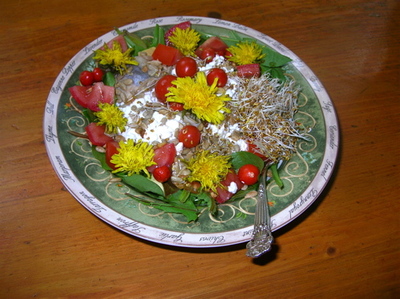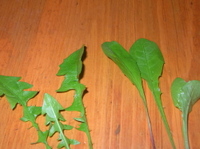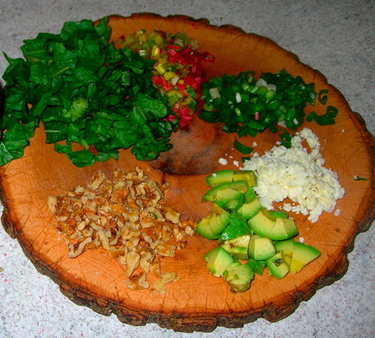I admit it; I share the usual North-American prejudice against dandelions. But both the weather and I are so seriously behind this year that I’ve started adding dandelion leaves from my weeding excursions to the few spinach, lettuce, mustard, and chard leaves big enough to cull.
After all, the things are chock full of good stuff: vitamins A and C, plus iron (more than in spinach), phosphorus, and calcium.
I wasn’t at all sure that the various sons and husbands on the premises would tolerate this addition, but there have been no complaints, and the salad has been disappearing at quite a clip. Today I took the next step: I added the flowers to my salad. They, too, have vitamins A and C. Here’s the result:

Several years ago I noticed there seemed to be two different sorts of dandelion around, one with its familiar, deeply lobed leaves,  and one with much shallower indentations. The second seemed far more palatable–lighter, less bitter, more tender– than leaves of the one, the true, the original dandelion. I prefer the interloper for both texture and flavor.
and one with much shallower indentations. The second seemed far more palatable–lighter, less bitter, more tender– than leaves of the one, the true, the original dandelion. I prefer the interloper for both texture and flavor.
But I began to wonder if I was poisoning my family (heavy metals yesterday, toxic greens today–as son #2 says, That’s how we roll–) so this afternoon before lunch I spent some time on the Web, with the result that I am now thoroughly confused. In summary: there are two different plants–false dandelion (Hypochoeris radicata), and fall dandelion (Leontodon autumnalis)–that might be mistaken for the common dandelion, but sources disagree about which has shiny leaves and which hairy, and almost no source covers both.
I can’t say, then, what precisely I’m eating, which is not good. However, a number of sources did state that none of the close look-alikes are poisonous, and that’s good. So I went ahead and ate my salad.
Which was delicious.




 Subscribe to RSS feed
Subscribe to RSS feed


